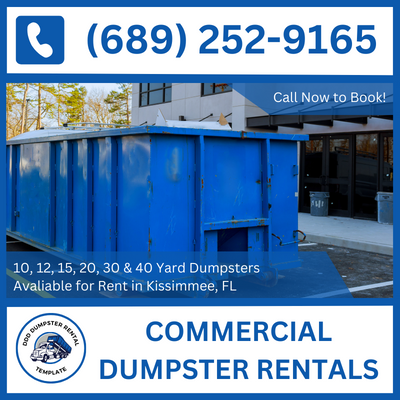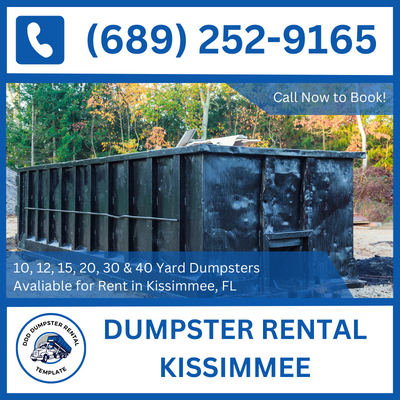- Get link
- X
- Other Apps
- Get link
- X
- Other Apps
The Critical Role of Dumpster Rentals in Commercial Construction Projects
The demand for large-scale construction projects continues to rise each year. As urban populations expand and infrastructure ages, major commercial renovations and builds are needed at increasing rates. While these complex projects promise immense value, they also pose immense logistical challenges—especially regarding waste management. As demolition work starts and new structures take shape on build sites each day, the amount of debris quickly accumulates. From fragmented concrete and twisted rebar to excess wood, drywall, and other materials, navigating this debris clutter responsibly is crucial.
This is where dumpster rentals provide an optimized, efficient solution. By deploying the right container rental at strategic areas around the site perimeter, crews can safely organize and contain all generated waste properly. Not only does this eliminate hazardous clutter, but it also boosts project productivity. Workers save time by directly hauling debris to centralized dumpsters compared to loading up trucks for off-site transport. Studies show utilizing temporary roll-off waste containers can improve construction workflow efficiency by over 25%*.
Below are key reasons specialized construction dumpster rentals are an indispensable tool for orchestrating any major successful build:
- Enhanced jobsite safety
- Optimized efficiency and tighter project timelines
- Lowered waste disposal costs and fees
- Improved site organization
- Facilitated regulatory and sustainability compliance
By understanding dumpster rental best practices outlined in this comprehensive guide, you can strategically implement a waste management system to drive success across all your upcoming construction projects.
Benefits of Construction Dumpster Rentals
When we think of construction sites, images of towering cranes, busy work crews, and half-built structures likely come to mind first. But what about the massive accumulation of debris and waste generated behind the scenes?
Old concrete being jackhammered away, splintered wood from framing, empty joint compound buckets...you name it.
Without proper waste management, these materials quickly create hazardous clutter while also wasting money and time.
That's why having reliable dumpster rental units on-site works magic compared to chaotic open-air debris piles or loose pickup trucks brimming with trash. Let's walk through the perks step-by-step, so you can see why construction pros depend on dumpsters as their not-so-secret weapons for completing ambitious projects on time and under budget!
Enhancing Safety
In this business, jobsite safety is 100% non-negotiable. Loose debris lying around means high risk for slipped discs, nasty gashes from protruding nails, and even collisions with large fragments. It's a huge liability even if everyone tries their best to be cautious.
- However, containing waste immediately in enclosed dumpsters right when it's created prevents these hazardous situations for your crew.
- It also protects the general public if your site borders pedestrian areas. You don't want passersby getting hurt from flying shards of OSB!
- Lastly, centralizing waste makes inspections simpler since you know precisely where to look. OSHA regulators notice organized diligence.
So it's simple - heightened jobsite safety protects workers, reputation, and the bottom line.
Streamlining Efficiency
Now onto the operational side of things. Construction revolves around finely orchestrated workflow amongst dozens of people.
- When waste cleanup gets backlogged for days on end before proper disposal, this slows everyone down.
- However, placing dumpsters around the build perimeter offers convenient receptacles for swift debris removal from the main activity.
- Rather than needing to repeatedly halt tasks for loading/transport time, your crew maintains momentum on priority value-building tasks instead.
- Studies confirm projects with reliable dumpsters on-location can achieve efficiency gains over 20% versus ad hoc truck loading!
Keep the momentum and use dumpsters for speed.
Cost Savings
Saving money is naturally appealing too. But how does contained waste disposal produce savings compared to traditional open-load methods?
- Firstly, by containing debris immediately rather than needing to haul it away repeatedly whenever trucks fill up, you minimize rental fees for those vehicles.
- Secondly, workers make fewer runs to distant landfills or transfer stations. Less trips = major fuel savings.
- Estimates indicate potential yearly savings exceeding $50k for larger contractors!
Yeah, keeping thousands of dollars in your pocket rather than sending it up in diesel fumes or rental contracts sounds pretty wise if you ask me!
With boosted safety, workflow, and affordability, it’s easy to see why construction dumpsters are truly magic workflow weapons!
Choosing the Right Dumpster Rental
So you’re convinced setting up an on-site dumpster program will make your project workflow awesome. But with so many sizes, styles, rental durations available, how the heck do you configure the perfect dumpster fleet?
I know it can feel overwhelming like staring at a massive menu trying to figure out what to eat! Let’s break the process down into a few key factors to make it digestible:
Estimate Your Debris Volume
- Glance over those CAD blueprints and permits to tally up expected materials usage and demo quantities.
- Approximate how many drywall sheets, wooden form boards, masonry bags will get consumed.
- Don’t forget other common items like metal studs, wiring spools, fastener boxes too.
- This volume estimate sets the containment capacity needed so no overflows occur.
Container Size and Type
Next up – dialing in the best dumpster dimensions and style. Consider aspects like:
- The largest debris chunk sizes expected
- Total haul weight
- Pickup truck clearance heights
Standard sizes range from 10 yards to 40+ yard capacity. Bigger is not automatically better if it disrupts site circulation flow!
Common types are:
- Standard roll-off dumpsters
- Compactors
- Recycling focused units
- Hazardous waste compliant
I like reminding clients that dimensions matter more than label names. Make sure to ask haulers for the exact lengths, widths, and heights that work on your property footprint.
Oh and don’t forget – wheel vs skid style dumpster bases!
Positioning
- Where will you place dumpsters around the site perimeter to avoid bottlenecking traffic?
- How far from demolition zones or material storage areas?
- Can trucks access that spot safely?
Little details like convenient positioning make all the difference for heavy use. Take time mapping this out.
Environmental Factors
Finally, consider rules for your region:
- Will local codes allow certain container types based on fire/collapse safety or drainage concerns?
- Are there sustainability reporting requirements to account for recycling programs?
- What are the weight limits for debris loads to avoid surcharges?
Preparing for and Managing the Rental
You’ve explored the awesomeness of on-site dumpsters. You’ve sized up the perfect containers for maximum project enhancement. Now let’s switch gears to discuss streamlining delivery, permits, and usage when the roll-off units arrive.
Properly setting up anything new at a complex job site feels daunting. But I’ll provide easy checklists so you can just focus on high-level oversight rather than sweating the small stuff!
Selecting a Rental Company
- Research options in your region for pricing and service reliability
- Check reviews and ask colleagues for recommendations
- Inquire about additional dumpster services like itemized waste reporting or recycling
- Look for responsive account management for any usage changes
I always say strong partners make all the difference during hectic projects!
Scheduling Delivery
- Finalize approximate start and completion dates for better cost negotiating
- Map out target equipment delivery dates around groundbreaking
- Build buffers into the schedule for bad weather or other delays
- Clarify if weekend or overnight drops are available
Saving money and avoiding disruptions means planning smart timelines upfront.
Securing Permits
- Verify your municipality's specific container dimensional rules
- Complete any temporary structure permitting paperwork
- Pay attention to screening or drainage system requirements
- Be ready to adapt layouts or adjust dumpster delivery coordination
I know permitting can be mundane but don’t skip compliance steps!
Usage and Loading
- Label each dumpster by type as needed (wood, metal, concrete, etc)
- Set expectations for debris sorting to maximize fill efficiency
- Remind all teams about forbidden items like paints or chemicals
- Institute safety protocols for proper PPE and equipment operation
Promoting safe, sustainable waste habits from Day 1 prevents so many headaches!
Additional Factors to Consider
We’ve touched on a bunch about sizing, permits, and scheduling for dumpsters. But a few final considerations exist too for exceptionally smooth management:
Safety Enhancements
- Ensure dumpster rental company provides clear signage and reflectors for visibility
- Add barricades or protective barriers if risk to the public near container access points
- Enforce PPE and spotter policies for unloading debris from heights into dumpster
Vigilance for hazards protects the project’s perfect safety record!
Recycling and Sustainability
- Discuss options for source separated collection bins for high volume materials like wood or metal
- Check for waste-to-energy conversion or compost partnerships to reduce landfill waste
- See if mixed recycling dumpsters are available if further sorting is infeasible
Every bit helps the environment in this business!
Community Relations
- Proactively notify nearby businesses or residents of potential access lane closures
- Address any concerns over typical dumpster-related noise, odors, visibility issues
- Make sure rental equipment looks crisp with regular pressure washing
Avoiding public complaints makes site managers smile. Need I say more?
Frequently Asked Dumpster Questions
We've covered so much awesome info already. But let's wrap up with common FAQs I still hear regularly when chatting dumpsters!
What safety perks exist by containing debris immediately?
Great question! Quick containerization creates that vital physical barrier between workers and hazards like:
- Sharp concrete chunks
- Scrap metal gashes
- Splintery wood slabs
- Contaminated materials
It also protects the public if pedestrian zones are nearby. Lastly, OSHA digs orderly sites so fewer violations get handed out.
How can dumpsters improve actual construction workflow?
Consolidating scattered debris piles into a single containment zone means:
- Faster access when tearing down walls or digging trenches
- Not needing to constantly pause for loading up pickup trucks
- Less rental equipment wrestling with small loaders
- Overall smoother site circulation
Workers can focus on priority builds rather than waste wrestling!
What impacts rental costs? How can I save money?
Major factors like:
- Container capacity
- Rental duration/quantity
- Transportation distance
- Region/seasonal demand
Cost cutting tips:
- Take time finding the best regional rate structure
- Leverage long term rentals for better volume discounts
- See if lockable lids deter contamination fees
A little strategic planning goes a long way!
What’s better – multiple small or single large dumpster setups?
Great question! Each approach has advantages:
Separate Units
- Easier to segregate certain waste types
- Can place nearest debris sources
- Provides redundancy if one fills faster
Consolidated Rental
- Simplicity of single supplier contact
- Volume discounts for larger capacity
- Less risk of circulation blocking
Evaluate tradeoffs for your specific site and access factors!
Conclusion
When you embark on major construction projects, effectively managing the sheer amount of waste and debris generated should never be an afterthought. As we've explored here, deploying the right dumpster rentals is a powerful yet inexpensive solution to implement centralized waste disposal and achieve far more efficient, safe, compliant, and profitable operations overall. By proactively planning your rental size, placement, logistics, recycling options and more rather than scrambling reactively, you magnify cost savings and risk reduction across every construction site. So use these tips and transform debris from hindrance to catalyst for build success today!
The Area we Service in Kissimmee and Osceola County, FL



Comments
Post a Comment